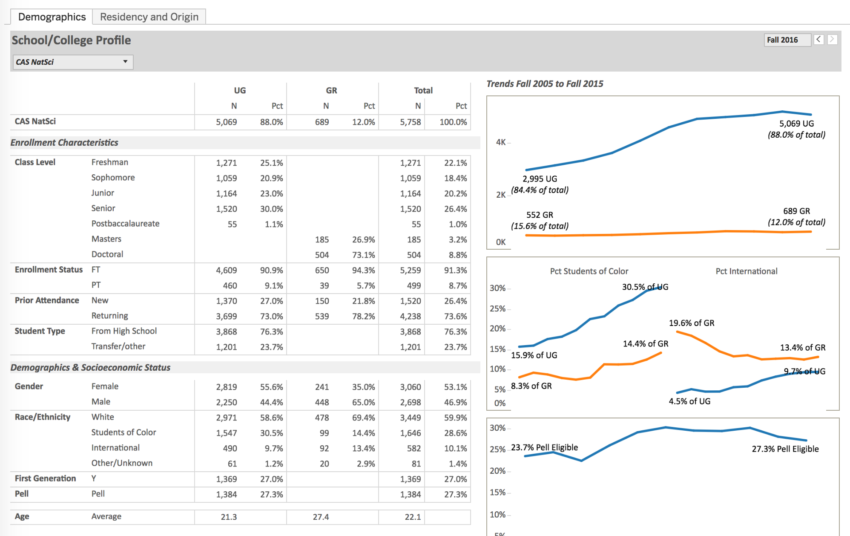Last updated on 03/07/2017
I first started writing about the Arts and Administration Program (AAD) and Doug Blandy’s $1M credit hour scam back in 2014:
1/23/2014: VPAA Doug Blandy pulls off daring $1M student credit hour heist

… Starting somewhere around 2006, when Doug Blandy took over as Director of the Arts and Administration program in AAA, he started adding many new online versions of these classes, taught with underpaid NTTFs.
Let’s do some math: For 2011-12 they taught about 2100 students, 4 credits each. Under the Shelton/Bean budget model, AAA gets ~$112 per credit, maybe a bit more given all the “self-supporting” online and summer courses. Let’s call it $1,200,000 or so. Gotta pay the adjuncts though. For the first one I checked, pay was $15,000, for 0.49 FTE. Slick – no benefits to worry about. Assume that’s for 4 courses, so labor costs are about $4000 a course. 44 courses or so a year, that’s $200,000 for labor, tops. So it looks like AAA and Blandy’s AAD program have been pulling down close to $1,000,000 a year, net, from this scheme.
But why would our undergrads go for these AAD courses? Wouldn’t they take art appreciation courses in the Art History department, from a professor with a respected research program, like, say, this one, or this one, or this one?
Well, no. The AAD courses satisfy both Arts and Letters *and* multicultural requirements. The legendary twofer. And even better, you can do the AAD courses online and get a friend to take the exams for you. [CAS requires proctored exams for on-line classes, AAD does not.] And regular Art History courses are hard. The average grade is 2.9. Less than a 3% chance of an A+.
But in the AAD courses, as of Fall 2011, the average undergraduate grade was 3.4. This is almost the highest for any UO department outside the Education school and Military Science. 19% of AAD students got an A+. 60% of the students got an A:
Rumor has it that President Schill and Provost Coltrane are now going to put an end to this by folding the AAD MA degree and its two TTF into PPPM, and laying off most of the NTTF faculty.
Today UA Faculty Union President Michael Dreiling has an Op-Ed in the RG, defending the AAD program:
… There is no indication that these decisions are about budgets or finances. Enrollment in the major is strong, and the curriculum serves historically underrepresented students. More than 25 percent of recent majors are students of color and 10 percent are nontraditional students. Graduates of the program are leaders in the arts and nonprofit scenes throughout the country. The Arts and Administration program’s curriculum has roots that extend more than 40 years at the UO, and the faculty have given decades of their careers and lives to build this successful program.
In return, the university plans to give most of these faculty a pink slip.
The justification for eliminating up to 13 non-tenure-track faculty jobs was not budgetary, or based on poor faculty performance or low student demand: It was that the program has too many non-tenure track faculty teaching classes. Eliminating these faculty positions was an easy way for administrators to instantly improve metrics. Such an approach runs counter to academic shared governance. …
I’m with Dreiling on the faculty layoffs. UO should do everything possible to find other assignments for them, and at a minimum long term faculty should be given more than a few months to find a new job.
But as for the AAD program itself, it is a prime example of the race to the bottom created by the Bean/Shelton Budget model. It never should have been allowed to take so many undergraduate students away from core Gen Ed Humanities classes in CAS. As for the argument that AAD
“serves historically underrepresented students. More than 25 percent of recent majors are students of color …”
If you are into slicing and dicing our students by race, the IR website does a great job of it. 25.3% of UO’s students are now “Students of Color” while only 23.3% of AAA’s are (they don’t break it out by department.)
Interestingly, CAS Natural Sciences seems to have the highest ratio, with 28.6%. More here:



@Dreiling
Way too many of our “metrics” involve check list items and quota distributions. As, UOmatters points out, we have a system where rewards increase, the higher the percentage of A+’s are given in a class. Is that the kind of “Academics” that the union stands for?
Good call on going after the union. I don’t think you can read what Dreiling said as anything other than a full-throated endorsement of the grading practices in AAD C. 2011.
I know it can be read otherwise.
Their grading practices haven’t gotten better. For 2016, with the admirable exception of one particular NTTF, AAD 250, 251, and 252 are averaging about 80% A’s. The info is from the Emerald’s website at https://emeraldmediagroup.github.io/grade-data/.
The Emerald says: “Data from 67 percent of the 48,309 classes was redacted by the UO Public Records Office and is not displayed here.” So perhaps UOM is putting a bit more credence in that website than warranted.
Some of the data is off, too (checked my own classes). Accurate more often than not, but perhaps buggy.
If there is/was a problem with the academic rigor or grading practices then that is an issue that should be addressed through discussion, expectations and accountability. But not by firing people from a popular program. Students obviously want this program, and not just for the ‘easy A’ as implied here. We are the flagship liberal arts ( as well as research) university after all
What does that course have to do with liberal arts?
I bet the same people defending this course rolled their eyes when the sports product management program was announced.
This is a sad example of UO Matters turning a tragedy impacting many departments and dozens of faculty across campus into a personalized flare-up with your long-time nemesis Doug Blandy. The cuts that Dreiling describes should concern you too since academic decisions are clearly bypassing the Senate.
The Senate Budget Committee has an upcoming meeting on these cuts.
If longterm NTTF who have done yeoman service in respectable financially viable programs are being let go to make room for TTF in order to preserve UO’s AAU status, then it is WRONG.
Dreiling’s main point is that there is no indication that this decision has anything to do with budgets or finance. We can use this moment to bash Dreiling (or the union by extension) over support of AAD by having a dubious online argument with insufficient data about many aspects of the program. Or we can focus on the brutal fact that more than 80 faculty members have just lost their jobs, with very little good justification offered by the administration.
Much of this post and the comments here seem to be focusing on a particular issue with AAD (the grade inflation) and then conflating that with the op-ed’s main point (raising concerns about the way in which some decisions are being made about hiring, firing, and resources at UO). AAD was just one example in the op-ed of where academic decisions are being made by the administration – shouldn’t the Senate be central to these decisions and shouldn’t there be a transparent process for this? – to the detriment of the careers and livelihoods of many hardworking NTTF around campus. Shouldn’t that be our focus? Where is the concern about how NTTF are being treated and the effects of these decisions on students and their education?
The lack of transparency on this has sure been a problem. I learned about it the same as everyone, from last week’s RG article. We went through similar cuts in CAS last year, and CAS Dean Andrew Marcus made sure there was plenty of consultation with the union, etc.
This year Provost Coltrane, no friend of transparency, seems to have botched the process.
I’m glad we agree about AAD’s grade inflation problem. The Daily Emerald is now tweeting students, suggesting they check the online database to find easy grading professors before picking classes: https://twitter.com/DailyEmerald/status/838975244949942272
Our students will have no problems finding an AAD instructor giving out more than 80% A’s, for an online class with no proctored exams that will satisfy both the humanities general ed requirement and the multicultural diversity requirement. And people wonder why CAS Humanities enrollment is shrinking, and why we have NTTF layoffs there?
The faculty and the Senate can’t expect to have much input on tough decisions like cutting faculty when we can’t even deal with the grade inflation problems and general race to the bottom created by the administration’s RCM budget model. In the Senate’s defense it wasn’t until this year that Brad Shelton was even willing to admit that the budget model created these problems.
Speaking of grade inflation, what’s up with your EC 201 curve?
Honors class.
I have been teaching courses in the HC for 13 years and have taught about 22 of them (I often teach more than one per AY).
The issue of grading an HC class is complicated and never really discussed. But yes, the average grade in my HC classes is significantly larger than non HC classes.
I do actually think this is an issue, but no one is willing to discuss it, let alone think about it.
There is certainly a student expectation that no grades lower than a B would ever be given in an HC class and I think there is something wrong here, but like I said, it is never discussed.
The discussion of AAD’s future, as well as the restructuring of AAA, was done in consultation with the faculty. However, in retrospect, Coltrane and Lindner were just aiming for the appearance of a collaborative process. Faculty input didn’t appear to factor substantially into final decisions.
I’m curious that no one is talking about the cuts in the COE. Has anyone identified whether these were teaching faculty or clinical faculty? They have a trend of decreasing enrollments at the masters level but have hired many new TTF and administrators in recent years.